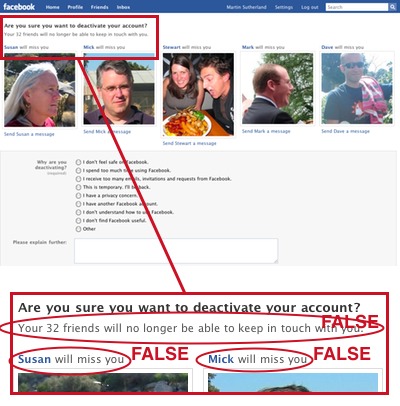After a long, full, and happy life, my grandmother Florence McLean died peacefully this morning.

We miss her a lot.
No gods, no kings, no billionaires
After a long, full, and happy life, my grandmother Florence McLean died peacefully this morning.

We miss her a lot.
I don’t make a secret of the fact that I don’t like Facebook. Where others find it playful, I find it intrusive and annoyingly attention-seeking. I don’t like its attitudes towards content ownership and privacy. I particularly don’t like its sense of self-importance, and the greedy way it tries to assume control of my social graph. It’s not that I don’t want to connect with my friends over social networks, but I want it to be on my terms, not theirs.
Additionally, whenever you’re dealing with a company that handles anything of value to you (with banks it’s money, with Facebook and Google it’s personal data), you have to weigh up the trust you have to place in them against the benefit you expect to receive. Google passes that test for me (for now), but I don’t trust Facebook not to try and screw me over.
What happens when you try to leave Facebook is emblematic of this. Here’s the page you get when you try to disable your account:

Asking me to confirm that I want to deactivate my account is appropriate. Using my social connections in a clear attempt to trigger an emotional response that will keep me on the service is absolutely not.
“Your 32 friends will no longer be able to keep in touch with you” is nonsense. I assume that since they know how to use a web browser, they’re reasonably familiar with a computer, and probably have an email account they can use to reach me.
Below that, they display a random selection of my Facebook contacts with above each one the text “XXX will miss you”. Not only are these statements factually incorrect — they won’t miss me because I never used Facebook to communicate with them in the first place — but Facebook is almost literally putting words in the mouths of these people. Facebook has not asked them if they will miss me; it is using them as sock puppets to push its own message, which is “don’t go.” By using the emotional “miss you” phrase, Facebook is using its knowledge of my social connections to make me feel bad about leaving.
They are abusing my social graph for their own ends. It’s manipulative, unethical, and downright slimy.
Furthermore, if they are using my contacts to try to make me stay, it follows that if my friends have tried to leave Facebook, then Facebook may have used me, or at least my photo, to try to make them stay — something that I myself would absolutely not do.
Goodbye, Facebook. Martin will not miss you.
When it comes to security, I’m firmly in Bruce Schneier’s “refuse to be terrorized” camp. I’m sick of the “we must do something” panic reaction that follows even minimal terrorist threats, and the security theatre it leads to. It’s not about the inconvenience it causes me and other passengers; it’s not even about the ridiculous costs that have to be borne by companies and taxpayers in order to implement measures that will do nothing to prevent a determined terrorist carrying out a attack — all they have to do, after all, is change their target.
It’s magical thinking: If we defend against what the terrorists did last time, we’ll somehow defend against what they do next time. Of course this doesn’t work. We take away guns and bombs, so the terrorists use box cutters. We take away box cutters and corkscrews, and the terrorists hide explosives in their shoes. We screen shoes, they use liquids. We limit liquids, they sew PETN into their underwear. We implement full-body scanners, and they’re going to do something else. This is a stupid game; we should stop playing it.
What’s most striking about the government’s response to this unsuccessful bombing attempt is the complete lack of any rational relationship between the actions that have been taken and are being proposed, any analysis of which of these and similar tactics did or did not contribute to the success or failure of the Christmas Day attack on Northwest Airlines flight 253, and any likelihood that they would make future attempts at terrorism less likely to succeed.
No, what bothers me is the fact that distorting public policy, removing individual liberties, and instituting a culture of irrationality and fear is exactly what the terrorists wanted in the first place.
Our job is to think critically and rationally, and to ignore the cacophony of other interests trying to use terrorism to advance political careers or increase a television show’s viewership.
So what can I personally do to refuse to be terrorized? Unfortunately, airlines and airports have a monopoly on air travel, and national governments have a monopoly on border control, so I can’t refuse to play the security game whenever I go abroad. I would if I could, because personally I feel more at risk from the security measures than I do from terrorist action. The risk of being subject of an attempted terrorist attack (much less a sucessful one) is, after all, less than being struck by lightning.
For one thing, I can help point out when people take the right approach. For example, The Register:
First: It is completely impossible to prevent terrorists from attacking airliners.
Second: This does not matter. There is no need for greater efforts on security.
Third: A terrorist set fire to his own trousers, suffering eyewateringly painful burns to what Australian cricket commentators sometimes refer to as the “groinal area”, and nobody seems to be laughing. What’s wrong with us?
I can also call bullshit on articles like this one on Travolution in which a tiny, poorly worded sidebar poll on a travel industry blog gets blown up to represent that a majority of all travellers are in favour of body scanners that would not have flagged the completely pants bomber in the first place.
But ranting about this stuff on my blog reminds me of the depressing inevitability of the war in Iraq in late 2002 and early 2003. No matter how much we, the people, protested — and the lead-up to the war we saw the biggest anti-war protests in history — our governments still went blithely ahead. I may have high hopes for the decade ahead, but an end to the ridiculous security theatre that plagues us is beyond even my wildest dreams.
While reading Jeremy Keith’s blog entry “Safari Askew” I remembered that I had looked at this just before Christmas, and found an answer.
The problem is to do with Safari 4’s “Top Sites” feature, which shows you a pretty grid of thumbnails for the sites you visit most regularly (or that you have pinned in place). The interesting thing is that these thumbnails are live (ish) previews of what those pages currently look like. If you don’t happen to have a Top Sites page open in a tab, and if Safari considers that the current thumbnail is sufficiently out of date, it will automatically go and retrieve the latest version.

This can cause headaches for site owners, because in order to show the actual state of the page, Safari relies on full page requests: it downloads all the HTML, CSS, images, and JavaScript for the page, and then displays everything exactly as if the user were viewing the page in a standard tab. Adverts are rendered, page tracking scripts are executed, and to the server it looks just like a regular page hit. This can lead to the site recording unnecessary actions, and your site analytics being all messed up.
At Skyscanner, for example, we noticed this because Google Analytics was showing an unusually high number of Safari users (8.5%) with an abnormally high bounce rate (the proportion of sessions where users view a single page, then walk away with no further interaction): Safari 4 users were twice as likely to bounce as other browsers. Useless sessions generated by Top Sites were the problem.
As Jeremy noted, the user agent that Safari 4 reports for a Top Sites request is exactly the same as for a normal page request. Fortunately, there is a way to distinguish the two types of request: in the current version of Safari 4 (4.0.4) the Top Sites request for the base page (but not its JS/CSS/image resources) carries an additional HTTP header, namely “X-Purpose: preview“.
An easy way to verify this is to use an HTTP debugging proxy like Fiddler or Charles to watch what happens when Top Sites makes a request — see the screen grabs below:

If your pages are dynamically generated, you can adjust your server-side code to examine the HTTP headers of the incoming request, and take appropriate action if this is a “preview” request. Here’s some sample PHP code:
<?php
if ($_SERVER["HTTP_X_PURPOSE"] == "preview") {
echo "preview";
} else {
echo "normal";
}
?>
("X-Purpose" is not a standard HTTP header, and you won’t find “HTTP_X_PURPOSE” in the PHP documentation. It’s the CGI specification that specifies how HTTP headers should be handled: they should be made into an environment variable with an “HTTP_” prefix followed by the header name, with dashes replaced by underscores. Hence, the value of the "X-Purpose" header is placed in the "HTTP_X_PURPOSE" environment variable, and retrieved as $_SERVER["HTTP_X_PURPOSE"].)
If all you’re looking to do it fix your site stats in Google Analytics, then you should just make sure that you don’t write out the GA tracking code for preview requests. If you are concerned about excessive load on your servers, unwanted user actions, or spurious advert impressions, you can take more aggressive action, perhaps by rendering a lightweight version of the page. An extreme possibility I considered was generating a completely different version of the page, specifically designed to look good in the thumbnail format of the Top Sites preview page:

However, doing this runs counter to the notion that these thumbnails represent previews, and I don’t know how your users would react. More importantly, Google might consider this cloaking, and come round your house in the middle of the night with a baseball bat. Just because it’s possible, doesn’t mean it’s a good idea…
2009 was the year of the re-read for me, and in particular the series re-read. I love diving into a series and living in the same world as the characters for weeks on end. At the start of the year I couldn’t find any new series I wanted to start on, so I went back to some old favourites:
I have read the first three series several times before already, and they are always fresh, and always fun. For a change, I read the Vorkosigan books in chronological order (although I started with Shards of Honor, rather than Falling Free), and in rapid succession. The early Miles books (The Warrior’s Apprentice and The Vor Game are still my favourites, and it turns out that Diplomatic Immunity isn’t as bad as I remembered it.
The Julian May books were less of a pleasure. If it weren’t for the “I’ve got this far so might as well keep going” sunk-costs argument, I would (should) have stopped about fifty pages into The Golden Torc. I remember waiting eagerly for the publication of Diamond Mask and Magnificat in the mid-90s, but now I just find the characters overly self-absorbed and melodramatic; I don’t think I’ll be re-reading them again.
Staying with Lois McMaster Bujold, 2009 saw the publication of the fourth and final book in her Sharing Knife series. I bought the first book, Beguilement when it was released in 2006, but didn’t read it at the time. I knew it was only the first part of a single big story, and having been burned by Peter F. Hamilton’s Pandora’s Star the previous year, I didn’t want to start on the tale, only to have to wait three years to get to its end. But when the fourth part, Horizon was published in February, I grabbed it and started from the beginning.
The Sharing Knife is a fantasy romance — not a combination that normally leaps off the shelves at me. But I trust Bujold to write characters I care about and a story that interests me regardless of my genre prejudices, and that is exactly what she has done here. The world she has created has more of an American frontier feel to it rather than a pseudo-medieval European vibe: prairies and riverside trading towns rather than dark forests and castles. Lakewalkers patrol the land on the lookout for malices, creatures that rise from the earth and feed on the life energy of everything nearby, and are capable of devastating entire towns. The malices are an ancient menace, but thanks to Lakewalker efforts over the centuries, a rare one now. So rare that many farmers don’t even believe in them any more, which causes tension when Lakewalkers come to town and require their aid. Because of the apparent safety, and the particular magical means by which Lakewalkers fight the malices, farmers have grown likely to fear and mistrust them, and call them witches, rather than heed their warnings.
The main characters are Fawn, a young farmer woman who has run away from home, and Dag, a grizzled Lakewalker veteran. They fall in love despite the large cultural gap that separates them. The books follow them as, outcast from their families and communities, they try find a place for themselves in the world, and to somehow reconcile these two parallel but highly interdependent societies.
Oh, and fight evil! The book covers may look all sweet and pastoral, but the plot is driven forward by the ongoing and very real threat of the malices. While I wouldn’t characterize the books as adventure stories, there is no lack of action. Bujold strikes a masterful balance between the clash-of-cultures love story and edge-of-your-seat thrills, and I can highly recommend the whole series.
(Just make sure you read the first two books, Beguilement and Legacy together, because it is really one book split in two — even the covers are two halves of a single piece. Three and four make up “part two”, but they are a looser pairing.)
Throughout November and December I also caught up on Steven Brust’s Vlad Taltos series (including an advance copy of Iorich thanks to Patrick at Tor). I know that I had read Jhereg before, and I’m pretty sure that parts of Yendi were familiar; what I can’t figure out is why the hell I would have read the first two books, but not gone on to devour the rest of the series, because it’s awesome. They are (for the most part) hard-boiled fantasy detective novels, not dissimilar in tone to some of my favourite contemporary detective series (Spenser, Elvis Cole, Myron Bolitar, et al.) The “detective” may be a witchcraft-using assassin, and his sidekick a miniature dragon (jhereg) on his shoulder, but the mean streets of the city are still mean, and when tough talk fails, knocking a few heads together often shakes loose the information required.
That only really describes the surface appearance of this series, though; the underlying world is rich and complex, full of Gods, Great Weapons, ancient sorcery, discrimination, social unrest, and peasant revolutions. Another thing that appeals to me about the books is that they are short, in the 200–300 page range. Steven Brust says what he wants to say, and then moves on. I like that. (Unfortunately his writing style in the other Dragaeran books has the opposite effect on me. I haven’t been able to get past the first few pages of The Phoenix Guards.)
Finally, some non-fiction. I have been interested in non-verbal communication since I picked up a copy of Allan Pease’s Body Language in the mid-eighties. In fact, this is one of the reasons I dislike working remotely. Phone calls strip out all the visual cues I use to pick up on the mood of the office, and to gauge unvoiced concerns in a meeting.
Joe Navarro is a former FBI agent with a background in interrogation and deception detection, and What Every Body Is Saying pays a lot of attention to reading the signals people emit during conversation. Navarro emphasizes that this is not about being able to tell whether someone is lying or telling the truth (although that does make for good TV), but rather about learning whether someone is confident or holding back, relaxed or stressed. When you understand that, you can try to guide the conversation to figure out why they are feeling that way.
Interestingly, this has significant use in usability testing. One of the tenets of usability testing is that you pay attention to what people do, rather than what they say. People are often reluctant to criticize, preferring instead to tell white lies about things they dislike. By studying their posture, gestures, and expressions during a test, and in post-test conversations, you can gain a much better understanding of their emotional state, and where problems lie.
This is definitely one of my top picks of the year. It’s very clearly written, and sprinkled with good illustrations, and not only does it make an excellent introduction to the subject of non-verbal testing, but it also rewards repeated reading and bite-sized dippings-into. Very excellent.
Dean Allen commenting over on Zeldman’s site during the discussion of why he shut down Favrd:
No fit of pique for me, actually. More like a gradual aha, with a slight wince and sigh at the end. I’ve spent the past year or so reading and writing and doing my level best to chip away at 40 years of belief in the logical fallacy that one’s identity meaning – self-worth, self-image, whatever you want to call it – can accurately be measured in the thoughts of others. Much as you and I may enjoy being encouraged through recognition and praise and dislike being saddened by rejection or indifference (god knows we’re taught to right from the outset by caregivers: good boy, pretty picture, heckuva job Brownie), deriving personal value from these transactions in the absence of a well-formed internal frame of reference through which you can decide on your own what does and doesn’t work, and subsequently accept the opinions of others as feedback, is just plain faulty thinking, of the sort that makes otherwise capable, centred people all loopy and weird.
I never used Favrd; I haven’t spent a lot of time thinking about the rights and wrongs of shutting it down so abruptly. What I have spent a lot of time thinking about is my own sense of self and self-worth. I intend to spend more time on this in 2010.